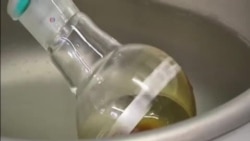ເປັນເວລາດົນນານມາແລ້ວທີ່ ບັນດານັກວິທະຍາສາດ
ພະຍາຍາມຈະຜະລິດຢາ ທີ່ມີປະສິດທິພາບ ເພື່ອປ້ອງກັນ
ແລະ ປິ່ນປົວ ໂຣກໄຂ້ຍຸງ ຫລື ມາລາເຣຍໃຫ້ຫາຍຂາດ ຊຶ່ງ
ເປັນໜຶ່ງໃນບັນດາພະຍາດ ທີ່ເປັນອັນຕະລາຍ ເຖິງແກ່ຊີວິດ
ທີ່ມີຜົນກະທົບ ຕໍ່ປະຊາຊົນ ຢູ່ໃນເຂດຮ້ອນ ໂດຍສະເພາະ
ແມ່ນພວກເດັກນ້ອຍ. ໃນຂະນະທີ່ອົງການອະນາໄມໂລກ
ຫຼື WHO ປະກາດແຜນ ເລີ້ມຕົ້ນການທົດລອງ ກ່ຽວກັບ
ຢາວັກຊີນໃໝ່ ທີ່ ມີຄວາມຫວັງສູງ ຊຶ່ງບັນດານັກວິທະຍາ
ສາດ ຢູ່ໃນອາຟຣິກາໃຕ້ ລາຍງານວ່າ ພວກເຂົາເຈົ້າກໍເຊັ່ນ
ດຽວກັນ ພວມຢູ່ໃນຂັ້ນຕອນສຳຄັນ ທີ່ໃກ້ ຈະສຳເລັດຜົນແລ້ວ.
ຜູ້ສື່ຂ່າວ ວີໂອເອ George Putic ມີລາຍງານ ກ່ຽວກັບການ
ທົດລອງ ສານປະສົມອັນໜຶ່ງ ທີ່ອາດປິ່ນປົວໂຣກມາລາເຣຍ
ໃຫ້ຫາຍຂາດໄດ້ ດ້ວຍການໃຫ້ຢານີ້ ພຽງຄັ້ງດຽວ.
ໄຊຈະເລີນສຸກ ຈະນຳເອົາເລື້ອງນີ້ມາສະເໜີທ່ານ ໃນອັນດັບຕໍ່ໄປ.
ມັນເບິ່ງຄືກັບວ່າ ການເລັ່ງຫາຢາປິ່ນປົວ ໃຫ້ຫາຍຂາດ ສຳຫລັບ ພະຍາດ ທີ່ມີຜົນ
ກະທົບຕໍ່ປະມານ 200 ລ້ານຄົນໃນແຕ່ລະປີ ແມ່ນໃກ້ ຈະເຂົ້າສູ່ເສັ້ນໄຊແລ້ວ ໃນ
ຂະນະທີ່ ກຸ່ມນັກຄົ້ນຄວ້າຈຳນວນໜຶ່ງ ລາຍ ງານວ່າ ການທົດລອງທາງການແພດ
ໄດ້ຮັບຜົນສຳເລັດໃນເບື້ອງຕົ້ນ.
ໃນປີ 2013 ຄົນປ່ວຍປະມານ 600,000 ຄົນ ໄດ້ເສຍຊີວິດ ຍ້ອນມາ ລາເຣຍ ສ່ວນ
ໃຫຍ່ແມ່ນພວກເດັກນ້ອຍ ຢູ່ເຂດໃຕ້ທະເລຊາຍຊາຮາຣາ ຂອງອາຟຣິກາ.
ດ້ວຍການທຳງານຮ່ວມກັນກັບ ບັນດານັກວິທະຍາສາດ ໃນປະເທດສະ ວິດເຊີແລນ
ແລະ ອອສເຕຣເລຍ ໂດຍຜ່ານອົງການ ບໍ່ຫວັງຜົນກຳໄລ Medicines for Malaria
Venture ນັ້ນ ບັນດານັກຄົ້ນຄວ້າຢູ່ທີ່ມະ ຫາວິທະຍາໄລ ນະຄອນ Cape Town
ລາຍງານວ່າ ຢາຊະນິດໃໝ່ MMVO48 ຂອງພວກເຂົາເຈົ້າ ແມ່ນໃຫ້ຄວາມຫວັງສູງຫຼາຍ.
ທ່ານ Kelly Chibale ອາຈານເຄມີດ້ານອິນຊີ ເວົ້າວ່າ “ພວກເຮົາ ໄດ້ສຳເລັດການ
ທົດສອບດ້ານຄວາມປອດໄພ ໃນຂອບເຂດທີ່ກວ້າງຂວາງມາແລ້ວ ຕາມທີ່ໄດ້
ບັງຄັບໄວ້ ແລະ ຂັ້ນທີສາມຕໍ່ໄປ ພວກເຮົາ ໄດ້ພິຈາລະນາເບິ່ງ ຂັ້ນຕອນການ
ຜະລິດຢາ ຂະໜາດໃຫຍ່.”
ທ່ານ Chibale ກ່າວວ່າ ຂັ້ນຕອນທຳອິດ ຂອງການທົດລອງ ທາງການແພດກັບມະນຸດ
ນັ້ນ ຢາດັ່ງກ່າວ ໄດ້ຂ້າພວກກາຟາກ ມາລາເຣຍ ໃນທັນທີ ແມ່ນກະທັງ ສາຍພັນທີ່ຕ້ານ
ທານຕໍ່ຢາ ນຳດ້ວຍ.
ທ່ານ Chibale ເວົ້າວ່າ “ແນ່ນອນແລ້ວວ່າ ເສັ້ນທາງແມ່ນຍັງຍາວໄກຢູ່ ທ່າແຮງ
ຂອງສານປະສົມອັນນີ້ ທີ່ໄດ້ສະໜອງຜົນຕ່າງໆ ໃຫ້ນັ້ນ ຖືວ່າ ມັນຫຼາຍເກີນກວ່າ
ທ່າແຮງ ເພື່ອທີ່ຈະສົ່ງຜົນ ຕໍ່ການຄວບຄຸມ ໂຣກມາລາເຣຍເທົ່ານັ້ນ ແຕ່ຍັງຈະ
ມີທ່າແຮງ ທີ່ຈະສົ່ງຜົນ ຕໍ່ການລົບລ້າງ ໂຣກມາລາເຣຍນຳດ້ວຍ ເພາະວ່າ ມັນ
ສາມາດກັນບໍ່ໃຫ້ມີການຕິດ ແປດໄດ້.”
ຈຳນວນຕົວເລກ ຂອງການເສຍຊີວິດ ທີ່ກ່ຽວພັນກັບໂຣກມາລາເຣຍ ໄດ້ຫລຸດລົງ ໃນ
ອັດຕາ ສະເລ່ຍ 47 ເປີເຊັນ ໃນໄລຍະ 15 ປີທີ່ຜ່ານມາ ສ່ວນໃຫຍ່ ໂດຍຜ່ານການນຳ
ໃຊ້ມຸ້ງ, ການສີດຂ້າຍຸງ ແລະ ການຮັກສາປິ່ນປົວ ໂດຍອີງໃສ່ຢາຕ່າງໆ ທີ່ມີຢູ່ແລ້ວນັ້ນ.
Scientists have long been trying to develop an effective protection
and cure for malaria - one of the deadliest diseases that affects people
in tropical areas, especially children. As the World Health Organization
announces plans to begin clinical trials of a promising new vaccine,
scientists in South Africa report that they too are at an important
threshold. George Putic reports, they are testing a compound that could
be a single-dose cure for malaria.
It looks like the race to find a cure for the disease that infects about 200
million people annually is close to the finish line, as several research
groups report successful initial clinical tests.
In 2013, some 600,000 patients died of malaria, most of them children
in sub-Saharan Africa.
Working in cooperation with scientists in Switzerland and Australia,
through the non-profit Medicines for Malaria Venture, researchers at
the University of Cape Town report their new drug MMVO48 is very
promising.
((KELLY CHIBALE, ORGANIC CHEMISTRY PROFESSOR))
"We have done extensive safety testing as a requirement and then
thirdly we have looked at the process of manufacturing the drug on a
large scale.
Kelly Chibale says in the first phase of human clinical trials, the drug
instantly killed even the drug-resistant strains of malaria parasites.
((KELLY CHIBALE, ORGANIC CHEMISTRY PROFESSOR))
"Of course there is a long way to go, the potential that this compound
offers is more than just the potential to impact malaria control, but also
the potential to impact eradication because it is able to block transmission"
The number of malaria-related deaths has been reduced by 47 percent
over the last 15 years, mainly through use of bed nets, spraying against
mosquitoes and therapies based on existing drugs.





